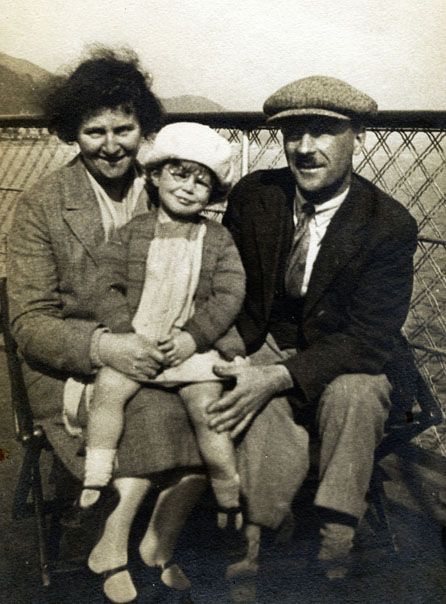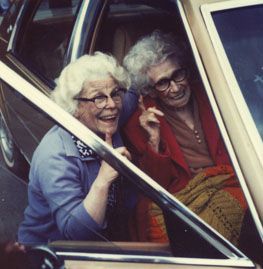
Joy’s Biography
On A Passionate Journey
Growing up as an only child, Joy Coghill was used to initiating her own theatre. She lived in her imagination, singing, dancing and acting all the parts. She grew up in a time when a career in theatre was unlikely, when mothers didn’t work outside the home. And yet, she would forge a career as an accomplished actor, director and teacher; she would raise a family through the demands of an unorthodox life, create Canada’s first professional children's and seniors’ theatre companies, and be recognized by her country for her pioneering work in helping to forge a country’s vibrant, cultural identity.

Joy with her Parents
Born on May 13, 1926 in Findlater, Saskatchewan to Reverend George Coghill and Dorothy (Pollard) Coghill, the family moved to Scotland where a milder climate would be kinder to her ailing father. After he died in the first year of World War II (1939), Joy and her mother returned to Canada, settling in Vancouver where Joy attended Kitsilano High School. She took also elocution lessons, and eventually earned an Associate of Trinity College, London, which qualified her to teach. This proved valuable in 1944 when she entered the University of British Columbia (UBC) to study Social Work. Money that had been put aside by her father for her education was tied up in red tape and Joy worked her way through university.
Joy had first appeared on stage at the age of 15, in a Vancouver Little Theatre production of Bunty Pulls the Strings, in 1941. At UBC, she became deeply involved with the U.B.C. Players Club and The Summer School of the Theatre, acting, directing and teaching under the inspirational guidance of drama teacher and early mentor Dr. Dorothy Somerset. Then, her life changed when she discovered that it actually was possible to get a Masters Degree in Theatre. At the time, no advanced courses in theatre were available in Canada.
She applied to the Goodman Theatre at The Art Institute of Chicago, thinking that, if life in theatre wasn't the passionate living she envisioned she could always fall back on teaching. All the appropriate papers were ready but she had no idea how she was going to pay for it. It was at this point the red tape cleared and money put aside by her father suddenly became available and Joy was off to Chicago.
Just before leaving however, Joy met John Thorne, who was coincidentally studying to be a television producer at Northwestern University, just outside Chicago. While there, the relationship blossomed. They were married in 1955. They would have three children - Debra, Gordon and David - and John would become a successful television producer for the Canadian Broadcasting Corporation.
In Chicago, Joy was particularly inspired by the charismatic Charlotte B. Chorpenning who, at close to 80, was the vibrant, passionate creator of The Goodman Children's Theatre. Joy became Chorpenning's assistant, graduating in 1950 with a Master of Fine Arts degree.
Joy returned to Vancouver to teach at UBC, directed and acted at Sydney Risk’s Everyman Theatre, and spent a summer with the International Players in Kingston, Ontario. Finally, she returned to Chicago, to teach and direct at Goodman Theatre. While there, she received a letter from Dr. Somerset inviting her to create Canada's first professional theatre for children.
Holiday Theatre first found a home in 1953 at the Frederic Wood Theatre, on the campus of UBC but success and demand would push them out into touring the province and result in the company owning their own building and creating a thriving school for children and youth. Holiday would present over one hundred plays most of them original Canadian works. In 1967 Holiday Theatre became associated with the Vancouver Playhouse Theatre Co. when Joy became its Artistic Director.
The first female Artistic Director of the Playhouse, Joy inherited an audience, a staff and a commitment to the new Canadian play, from Malcolm Black. Indeed theatre history was about to be made with a groundbreaking new play first suggested by Black. On her first day, novelist George Ryga brought in an outline for a play titled The Ecstasy of Rita Jo. Joy and Associate Director Charlie Evans, decided it must be produced in Canada's centennial year, 1967. The play, directed by George Bloomfield, received rave reviews and was one of the first to address issues relating to Aboriginal people. Through the vision of colleague David Haber, Rita Jo would play at the opening of the National Arts Centre in 1969 - the only Canadian work at the opening Festival that was attended by Prime Minister Pierre Elliot Trudeau and the Premiers of all the Provinces.
In 1971, the CBC transferred Jack Thorne to Montreal, to produce drama, and Joy was appointed the first female Artistic Director, English Acting Section, of the National Theatre School.
After two years, in the post, Joy began to pursue acting full time. She appeared in films (her first one with David Cronenberg), on television and in theatre productions across Canada, for which she received rave reviews and numerous awards. Amongst her many principal appearances in film and on television, she is best-known for her roles in the critically-acclaimed
Da Vinci’s Inquest and
Ma, a CBC adaptation of her previous stage appearances as Margaret
“Ma”
Murray, the outspoken journalist and British Columbia’s first female newspaper publisher. Her theatre work included co-producing Noye’s Fludde(Britten) with Niki Goldschmidt, her prize-winning performances as Sarah Bernhardt in John Murrell’s
Memoir, Puck in the opera of
A Midsummer Night’s Dream (Britten) and Miss Helen in
The Road to Mecca.

Joy with the real Ma Murray
As a published playwright in both Canada and Israel, she is proud of her historical role in bringing Canadian playwrights into the light of the world stage.
In 1987, Joy wrote and produced Song of This Place based on the life of Emily Carr. Joy created The Alzheimer Project in 1998, one of the productions of Western Gold Theatre, which she founded in 1994 to showcase senior talent and to fight ageism in the marketplace. The staging of A Midsummer Night’s Dream, with actors all over 60, became the subject of a CBC documentary The Courage to Dream. Joy was also the company's Artistic Director until 1999. The Artistic Director in 2008 is Colleen Winton.
The importance of her work was recognized by her country when she was awarded the Order of Canada, in 1991. Among her many awards are the Governor General's Performing Arts Award, Jessie awards for best actress and significant artistic achievement, the Confederation Medal, the Canadian Silver Jubilee Medal, the Gascon Thomas Award, and the Herbert Whittaker Critics’ Association Award for Outstanding Contribution to Canadian Theatre.
Upon retiring, Joy threw her energy into what many would consider her most ambitious project. She collaborated with friend and colleague director Jane Heyman, on the creation of a building to house and support aging people in the performing arts... people who had dedicated their lives to cultural fabric of Canada, with little monetary gain, and no pension plan. Many were surviving on less than half the income of the average Canadian senior.
They founded PAL Vancouver in 2001 and, after five years of fundraising and planning, the Performing Arts Lodge (PAL), Vancouver, opened the doors to its 111 rental units in May 2006. Among the first residents were Joy Coghill and Jack Thorne. The building, of course, includes a 100-seat theatre.
“I've tried to live my life as passionately as possible. I am passionate about Canada and believed that, having done my best with what I've been given, theatre was the most important way to serve it.”
August 2008
All Rights Reserved Joy Coghill ©2008. Copywriting Susan McNicoll. Website: Thorne Branding & Design